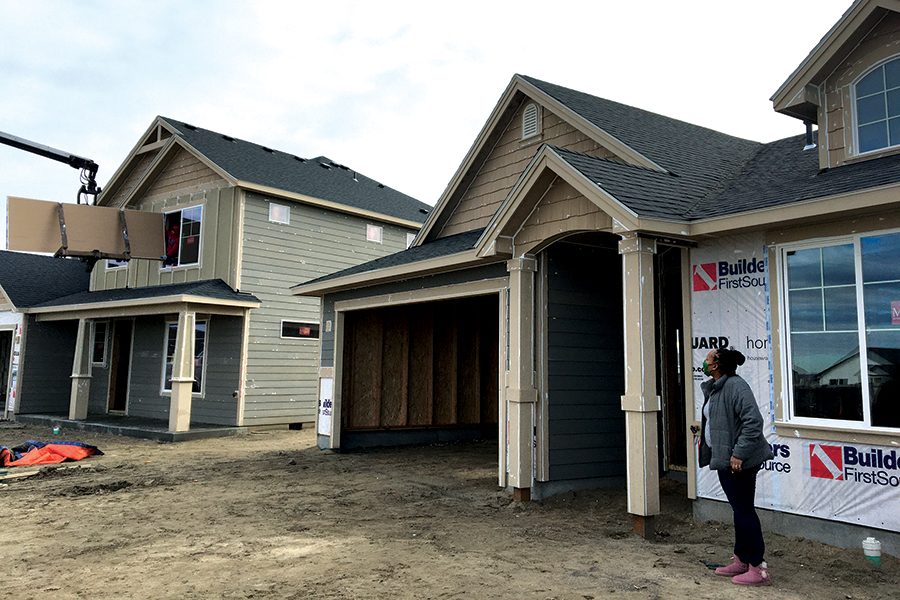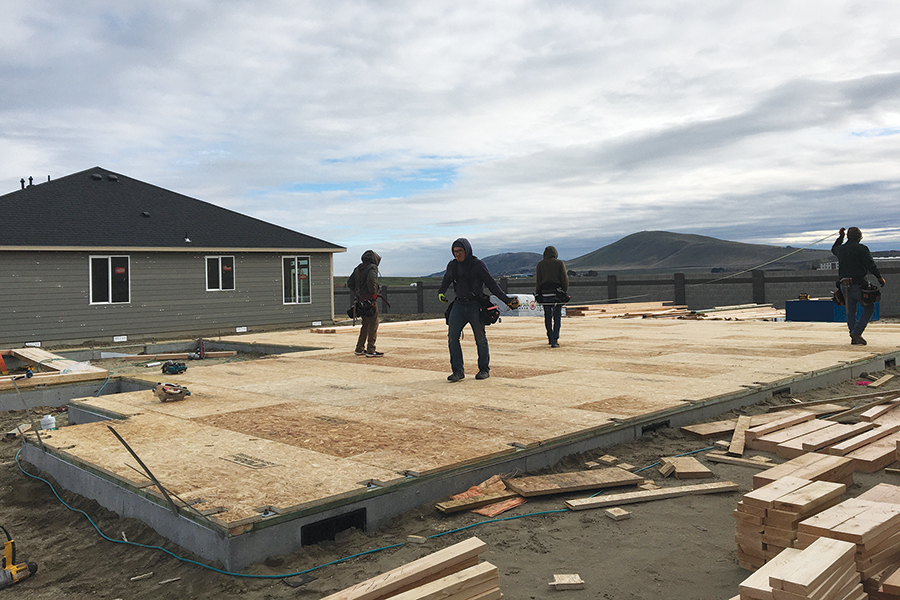
Home » Homebuilding pushes construction as commercial work lags
Homebuilding pushes construction as commercial work lags

February 16, 2021
Tri-City construction topped the $1 billion mark in 2020, no thanks to the Covid-19 work stoppages, slowdowns and even a lingering shroud of smoke that bedeviled the construction industry.
Overall construction dipped 13%, but homebuilding was a bright spot, according to figures compiled by the Home Builders Association of Tri-Cities. Collectively, local building agencies issued permits for 1,722 single-family homes worth about $500 million, 5% more than in 2019 for both value and permit volume.
“It was a good year for residential construction across the board,” said Jeff Losey, president. “Everybody was as busy as they possibly could be.”
Leah Mays and her husband, both Hanford workers, are buying their first home together, a custom-built single-family model at The Heights at Red Mountain Ranch, a new subdivision from Aho Construction in West Richland.
The first of 10 phases is taking off near Keene Road and West Van Giesen Street. With 103 of 105 lots under contract in late January, it is one of the busiest work sites in the region. Aho, based in Vancouver, expects to begin the second phase in the spring.
Sales have exceeded expectations despite a six-week halt to construction early in the pandemic, it said.
On a sunny January day, the Mayses threaded their way past construction vehicles to check on the progress of their home, a trip they make frequently. They chose a home site on the outer perimeter, close to a walking and biking path, and opted for a floor plan with three bedrooms and a charming dormer that gives the appearance of a loft. It is fake, Leah said.
Next door, a crew used a crane to hoist a pallet of drywall into the home of their future neighbors. Up and down the street, workers attended to foundations and framing and roofs and other tasks.
“They’re so fast,” she marveled.
Losey called The Heights at Red Mountain a critical “relief valve” for the Tri-City market, where the inventory of homes for sale fell below 300 in December, a quarter of the 1,200 that is considered normal. Demand pushed the median price to $310,000 in December, an 8% increase, according to the Tri-City Association of Realtors.
West Richland issued 230 permits in 2020, more than double the 120 of 2019.

Losey cautions that a fast market is not healthy for the economy. He cited a case of a buyer flipping a home after only a few months for a six-figure profit.
“It’s not sustainable,” he said. “It’s too much, too fast.”
Elsewhere, Pasco issued 524 single-family permits, more than any other jurisdiction but 55 fewer than in 2019, a drop of 10%.
Benton County issued 175 permits for single-family homes (+39%), Franklin County issued 91 (+21%), Kennewick issued 295 (-13%), Prosser issued 19 (-37%), Richland issued 386 (+5%) and Benton City issued two (-50%).
Commercial construction
Homebuilding soared but the pandemic chilled “other” construction, a category that covers everything from commercial development and government projects to pole barns and roof repairs.
There was $539 million of “other” compared to $700 million in 2019, a drop of 9%, according to HBA’s year-end report.
“What I’m seeing is a lot of hesitation in the commercial market,” said Joel Bouchey, regional coordinator for Inland Northwest Associated General Contractors.
Multifamily – apartment – projects continue as demand for housing remains strong, but hard-hit industries such as hospitality and leisure as well as office are cooling off. Government spending is easing too as a school-building spree ends.
For private projects, financing is a growing challenge, as are material costs. Lumber prices remain about 150% above where they were a year ago, a casualty of Covid-19 slowdowns in mills.
“Generally, national lenders have tightened requirements for those larger projects,” Bouchey said.
Columbia River Walk, a Pasco apartment complex at 2120 W. A St., opened two months late because of Covid-19 work slowdowns and the new restrictions that govern site safety, said Linda Henjum, who manages the property and others in the Tri-Cities on behalf of the owners.
It received a partial order of appliances that meant it could not fully equip the 60 units in the first phase. Too, utility workers were diverted to wildfires, another delay.
Henjum said the units were well received when they opened. The vacancy rate for Tri-City projects in her portfolio is less than 2%, a sign of unabated demand.
But the low vacancy rate conceals a Covid-19 challenge that could affect investment in apartment construction: Washington’s moratorium on evictions.
Henjum said the impact is significant. People affected by Covid-19 layoffs can get assistance. But some residents who are working simply are not paying.
“They’re basically squatting,” she said. “We’re just stuck.”
What is next?
Homebuilding will surge in the early part of the year. Builders raced to secure permits in January, before new energy codes took effect on Feb. 1. Gov. Jay Inslee declined to extend the date for the codes, which the HBA calculates add $7,500-$10,000 to the cost of most new homes.
The changing rules require ever-tighter standards for energy efficiency as the state pursues clean energy goals. Heat reclamation systems and other steps will become standard rather than add-ons.
Energy efficiency is good, but builders raced to get in under the old requirements.
“There’s a lot of permits being submitted right now,” Losey said in late January.
The new codes injected awkwardness into conversations with buyers, who were urged to sign contracts before the new codes took effect.
“It sounds like a sales tactic but it’s not a sales tactic,” Losey said.
Commercial construction could remain a mixed bag. The pandemic is felt the hardest in the hospitality and recreation industries. It is also unclear what offices will look like. Traditional office space is going empty.
It is unclear if workers will return when vaccination efforts take effect, or if working from home remains in place.
“The social experiment is on,” Losey said.
But demand for rental homes is strong and is prompting projects across the community. A 288-unit project at Horn Rapids is one of the larger in development, but smaller projects dot the region, from Willow Pointe to the Richland Wye and central Kennewick.
Bouchey of Associated General Contractors is hopeful government projects will pick up. The number of projects in the pipeline is thinning.
“We’re optimistic, but 2021 is looking a bit light. We’re hoping for more groups to go to bid,” he said.
It may have slowed but it is not at a standstill.
A $7.7 million visitor center in the form of a black hole is taking shape at Richland’s LIGO (for Laser Interferometer Gravitational-wave Observatory). Site work has started on a new military readiness center in north Richland and all three cities are building new fire stations.
And, notably, the cities of Kennewick and Pasco both expect to launch major transportation projects this spring.
Kennewick and Pasco solicited bids for the Ridgeline underpass and Lewis Street overpass projects, respectively, in November. Bid openings were set for January but were delayed slightly.
However, both are expected to go forward. They escaped being delayed when Gov. Jay Inslee ordered the Department of Transportation to pause capital projects that went to bid after Jan. 11.
The local projects are funded through DOT via the Connecting Washington series of tax gas increases, providing critical transportation links.
Pasco’s Lewis Street overpass will reroute Lewis Street over the BNSF railroad tracks in east Pasco, retiring an old and dangerous underpass.
The Ridgeline Drive underpass will carry the street beneath Highway 395 and is designed to improve connections in west Kennewick while improving safety on the state highway, which intersects Ridgeline on a downhill grade.
The two transportation projects will add nearly $60 million to the total value of 2021 construction for the region – $36 million for Lewis Street and about $23 million for Ridgeline.
Real Estate & Construction Local News
KEYWORDS february 2021





